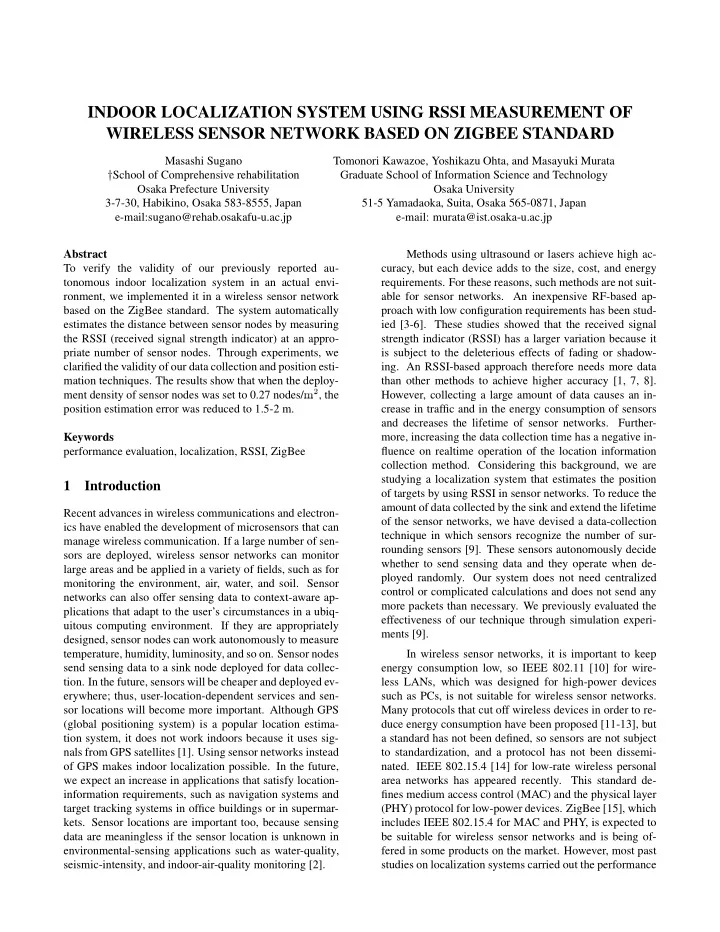

INDOOR LOCALIZATION SYSTEM USING RSSI MEASUREMENT OF WIRELESS SENSOR NETWORK BASED ON ZIGBEE STANDARD Masashi Sugano Tomonori Kawazoe, Yoshikazu Ohta, and Masayuki Murata � School of Comprehensive rehabilitation Graduate School of Information Science and Technology Osaka Prefecture University Osaka University 3-7-30, Habikino, Osaka 583-8555, Japan 51-5 Yamadaoka, Suita, Osaka 565-0871, Japan e-mail:sugano@rehab.osakafu-u.ac.jp e-mail: murata@ist.osaka-u.ac.jp Abstract Methods using ultrasound or lasers achieve high ac- To verify the validity of our previously reported au- curacy, but each device adds to the size, cost, and energy tonomous indoor localization system in an actual envi- requirements. For these reasons, such methods are not suit- ronment, we implemented it in a wireless sensor network able for sensor networks. An inexpensive RF-based ap- based on the ZigBee standard. The system automatically proach with low configuration requirements has been stud- estimates the distance between sensor nodes by measuring ied [3-6]. These studies showed that the received signal the RSSI (received signal strength indicator) at an appro- strength indicator (RSSI) has a larger variation because it priate number of sensor nodes. Through experiments, we is subject to the deleterious effects of fading or shadow- clarified the validity of our data collection and position esti- ing. An RSSI-based approach therefore needs more data mation techniques. The results show that when the deploy- than other methods to achieve higher accuracy [1, 7, 8]. � , the ment density of sensor nodes was set to 0.27 nodes/ � However, collecting a large amount of data causes an in- position estimation error was reduced to 1.5-2 m. crease in traffic and in the energy consumption of sensors and decreases the lifetime of sensor networks. Further- Keywords more, increasing the data collection time has a negative in- performance evaluation, localization, RSSI, ZigBee fluence on realtime operation of the location information collection method. Considering this background, we are studying a localization system that estimates the position 1 Introduction of targets by using RSSI in sensor networks. To reduce the amount of data collected by the sink and extend the lifetime Recent advances in wireless communications and electron- of the sensor networks, we have devised a data-collection ics have enabled the development of microsensors that can technique in which sensors recognize the number of sur- manage wireless communication. If a large number of sen- rounding sensors [9]. These sensors autonomously decide sors are deployed, wireless sensor networks can monitor whether to send sensing data and they operate when de- large areas and be applied in a variety of fields, such as for ployed randomly. Our system does not need centralized monitoring the environment, air, water, and soil. Sensor control or complicated calculations and does not send any networks can also offer sensing data to context-aware ap- more packets than necessary. We previously evaluated the plications that adapt to the user’s circumstances in a ubiq- effectiveness of our technique through simulation experi- uitous computing environment. If they are appropriately ments [9]. designed, sensor nodes can work autonomously to measure temperature, humidity, luminosity, and so on. Sensor nodes In wireless sensor networks, it is important to keep send sensing data to a sink node deployed for data collec- energy consumption low, so IEEE 802.11 [10] for wire- tion. In the future, sensors will be cheaper and deployed ev- less LANs, which was designed for high-power devices erywhere; thus, user-location-dependent services and sen- such as PCs, is not suitable for wireless sensor networks. sor locations will become more important. Although GPS Many protocols that cut off wireless devices in order to re- (global positioning system) is a popular location estima- duce energy consumption have been proposed [11-13], but tion system, it does not work indoors because it uses sig- a standard has not been defined, so sensors are not subject nals from GPS satellites [1]. Using sensor networks instead to standardization, and a protocol has not been dissemi- of GPS makes indoor localization possible. In the future, nated. IEEE 802.15.4 [14] for low-rate wireless personal we expect an increase in applications that satisfy location- area networks has appeared recently. This standard de- information requirements, such as navigation systems and fines medium access control (MAC) and the physical layer target tracking systems in office buildings or in supermar- (PHY) protocol for low-power devices. ZigBee [15], which kets. Sensor locations are important too, because sensing includes IEEE 802.15.4 for MAC and PHY, is expected to data are meaningless if the sensor location is unknown in be suitable for wireless sensor networks and is being of- environmental-sensing applications such as water-quality, fered in some products on the market. However, most past seismic-intensity, and indoor-air-quality monitoring [2]. studies on localization systems carried out the performance
Recommend
More recommend